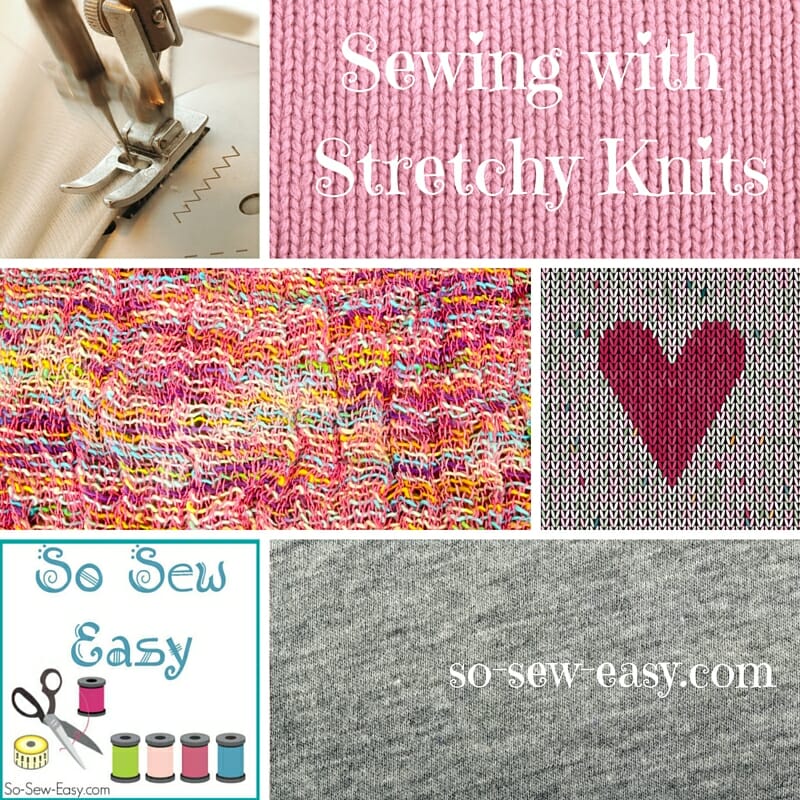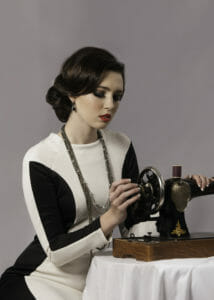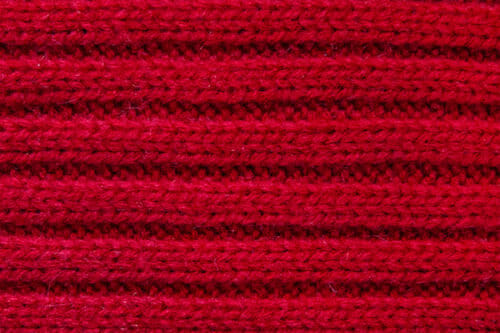
For many sewists, working with stretchy knit fabric for the first time can be daunting, but moving forward, many soon learn to love knits because of their elasticity and texture. Knits are also wrinkle-resistant and comfortable to wear.


The word knit is derived from “knot” and it originates from the Dutch word “knutten”. While knitting is the method that uses two or more needles to loop wool or yarn into a series of interconnected loops to produce knit fabrics or garments. It became popular in 1916 when Coco Chanel used knit fabric in her famous suits. Soon thereafter, knits became the fabric of choice for sportswear. Today, knit fabric is popularly used for sweaters, clingy dresses, cashmere turtlenecks, coats, and various other knitwear.
So what should we keep in mind when we sew using knit fabric? It is important to know that there are many kinds of knits as they come in different stretch, weight, and direction of stretch. All these attributes affect how to sew knits and should be used to determine what kind of project to stitch when using knit fabrics.
Woven fabric versus knit fabrics
Woven fabric is made up of at least two separate groups of yarns, called warp and weft while knitted fabric can be made from one yarn only. Weaving is interfacing two or more sets of yarns together to form a fabric. Knitting is the process of forming a series of interlinking loops in the yarn to form the fabric.


Warp knits and weft knits
There are two main types of knit fabrics namely warp and weft knits and the latter is the one commonly used by home sewers. Weft knits are produced by using basic knitting stitches such as knit, purl, tuck or miss. Combining these stitches also results in various knit textures and types. Furthermore, using different yarns, fibers and colors gives us various kinds of knit fabrics. The looseness and tightness of the tension of these stitches also determine the characteristics of the knit fabric.
Single knits
Single knit fabric (often called single jersey) is a more general term to describe knitted fabrics that are produced by knitting machines with only one set of knitting needles.
Jersey knits
One of the most common knit fabrics used by home sewists is the jersey. It is usually composed of cotton, wool, or synthetic blends and has moderate elasticity. Jerseys are commonly used when stitching pajamas, t-shirts, and hosiery. Wool jersey knits are often found in skirts and dresses. And since jerseys are produced by using only the knit stitch, it has a smooth front making them ideal for prints and a textured back with distinct right and wrong sides. Jersey stretches up, down, and across and tends to curl, so managing it can be a bit difficult.
Rib knits


Rib-knit, on the other hand, is a knit fabric that is ribbed throughout. It can be light to heavyweight and is highly elastic. Great for sweaters, tops, cuffs, and neck bands for jersey t-shirts, it is produced by combining purl and knit stitches. The result is a double-knit fabric with vertical rows of stitches that are joined alternately in the front and back. Rib knit fabrics have excellent shape retention.
Interlock or double knits
Interlock or double knit is usually composed of two layers, combined to produce one fabric since it is composed of two rows of stitches placed directly behind each other. It has more limited elasticity or stretch, is moderate to heavyweight, and is ideal for suits, pants, blouses, and tops. Both sides of the interlock knit are smooth, making it more stable than jersey knits so there's often no way to differentiate a right and wrong side. It is also thicker than jersey and is easier to manage to make it quite popular among home sewists.
Knowing the unique properties of jersey, rib, and interlock knit fabrics should make sewing with knit fabrics more enjoyable and satisfying. And there are still other types of knit fabrics out there with their own distinct attributes. So prepare your double-needle sewing machines, master a variety of zigzag stitches and you are ready to sew your stretchy knit fabric. Sew on!
As a refresher, we have done a number of popular articles about sewing with knits ourselves. Including a comprehensive Pinterest feature that you can check out below:
A very popular article of ours has been about how and where to use Knit Stay Tape
And last, but certainly not least, we did a post on the dramas involved in unpicking sewing in knit fabrics. We didn't have the ultimate answer on how to do this efficiently so you may want to review the reader comments as they share some useful tips and techniques.








[…] probably also notice that thinner knit fabrics have a tendency to curl on the edges. In this case, that's good because we are going to use that […]
The Craftsy link doesn’t go to the sewing with knits class 🙁 just wanted you to know so you can redirect it and get paid! otherwise great article thank you!
I would love to buy actual samples of fabric that were labeled – single knits, jersey knits, rib knits, interlock, double knits. Also with the fiber content such as % of polyester, cotton & spandex included! Every time I do a project with knits I save a sample of the fabric with the stitches I used. I write down the stitch type, length & width. I also write down the type of fabric with the fabric content such as the % of polyester, cotton & spandex. That way if I have something to refer to if I use that fabric again.
What a terrific idea! I do sticky notes of specific settings on my machine, but you are way more evolved. Way to go! And thanks a lot for sharing this.
I would use the fabric if I won from Fabric. com to make a dress for myself. then I would make as many chemo caps for cancer patients that are possible.
What type or knit are the fabrics with Lycra in them? I usually refer to them as swimsuit fabrics, but use them in skirts and dresses as well. Also, is type of knit best for leggings?
Great article! Thanks for all the information!
Hi MaryBeth, great question and one that I will need to address in a separate post. But basically Lycra is a fiber and it is present in many textiles. Jeans, bras, shapewear, swimsuits, and activewear. The percent of the fiber is what makes the fabric look and behave differently. The best fabric for leggings is entirely dependent on what do you want the leggings for. Exercise/Swimwear/Activewear: 88% polyester 12% Spandex. As legwear for spring and autumn I prefer natural fiber knits such bamboo (my favorite), cotton and rayon, cotton and linen knit. Really it is up to you what you want. One thing is for sure important that the knit has at least a 50% percent four-way stretch.
That gives me a lot more confidence regarding sewing with knits. Thanks for the advice. Really love your site!